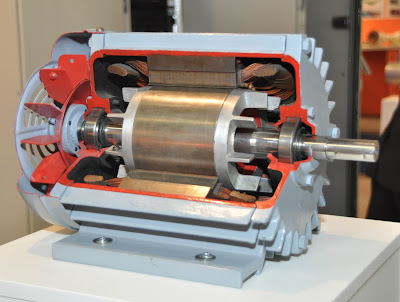 |
| Induction Motor Photo Credit - www.wikipedia.com |
Crawling
It has been found that induction motor practically this squirrel cage type ,sometimes exhibit,a tendency to run stable at speeds as low as 1/7th of their synchronous speed .This is known as crawling of induction motor. This action is due to ,the fact that the AC winding of the stator produces a flux wave which is not pure sine wave .It is a complex wave consisting of a fundamental wave which revolves synchronously and odd harmonics like 3rd,5th,7th etc. which rotate either in the forward or backward direction at Ns/3, Ns/5, Ns/7 speed respectively. As a result in addition to the fundamental torque ,harmonics torques also developed whose synchronous speed for fundamental torque. For Example Ns/n, where N is the order of harmonics torque. Since the 3rd harmonics current are absent in a balanced three phase system ,they produce no torque .Hence total motor torque has there components.- The fundamental torque rotating with synchronous speed
- Fifth harmonics torque rotating at Ns/5
- Seventh harmonics torque having a speed of Ns/7
Cogging
The rotor of particularly squirrel cage induction motor sometimes refuse to start at all particularly a when the voltage is low. This happens of stator teeth is equal to the number of rotor teeth ,and therefore due to the magnetic locking or cogging .It is found that the reluctance of magnetic paths is minimum when the stator and rotor teeth comes in front of each other, it is in such position of maximum reluctance that the stator tends to remain fixed thus causes serious trouble during starting.
This can be easily overcome by making number of rotor slots more than the number of stator slots and by giving slightly skew to the rotor slots (skewed).What is meant is to arrange the stack of rotor laminations so that the rotor slots are "skewed" or angled with respect to the axis of rotation. Constructing the rotor with skewed slots and providing more (or fewer) rotor slots than stator slots is the remedy for both cogging and crawling.
This can be easily overcome by making number of rotor slots more than the number of stator slots and by giving slightly skew to the rotor slots (skewed).What is meant is to arrange the stack of rotor laminations so that the rotor slots are "skewed" or angled with respect to the axis of rotation. Constructing the rotor with skewed slots and providing more (or fewer) rotor slots than stator slots is the remedy for both cogging and crawling.



0 comments: